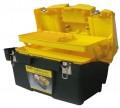Сompartments
The number of compartments and/or pockets provided in the design of the tool container (with the exception of organizers, including those built into the lid — for them the number of cells is indicated separately, see below).
The more compartments or pockets, the easier it is to keep numerous items in the container at the same time. On the other hand, more compartments (for the same product size) usually means smaller individual compartments. The most modest models have
up to 10 compartments / pockets, in the most capacious this number can
exceed 30. Of course, when choosing by this parameter, you should take into account the type of container (see above). So, for traditional boxes, the maximum value is actually
20 compartments, and among backpacks there are models with
20 – 30 compartments.
Sections
Design of movable sections mounted in a tool box or other container. A section is a separate movable unit, usually divided into several compartments (see above). The meaning of such blocks is to ensure the compactness of the container when folded and the convenience of access to the contents when unfolded. The types of sections can be as follows:
—
Sliding. Sections located at the top of the container and also playing the role of a cover for its lower part. Typically, such sections are made in pairs or quadruples, 2 pairs each, and when opened, in accordance with the name, they diverge in different directions, allowing you to get to the space below them. This variety is found mainly in boxes (see "Type").
—
Retractable. Sections that slide out of the inner volume of the container are like drawers in a desk or kitchen table. This design is used in organizers and
trolleys(see "Type").
Organizer slots
The number of individual cells provided in the organizer. In this case, we can talk about an organizer as a separate device (see "Type"), or a set of cells built into the lid of the box (see "Lid with an organizer"). And for solutions with removable partitions, in which cells can be combined, the maximum number is indicated — with all installed partitions.
Organizers, by definition, are designed mainly for small things. Therefore, the more cells there are, the more varieties of small items can be stored in a container. For example, in 10 cells you can keep bolts of five different sizes and separately nuts for them. Such a number of compartments —
up to 10 — is generally considered small, but in fact it is often quite enough.
11 – 20 cells can be called an average, and the most capacious organizers have
up to 30 compartments. However it is worth considering that with the same dimensions of the container, an increase in the number of cells leads to a decrease in their volume.
Place for bits and sockets
The presence on the lid of the box (may occur in other versions, but very rarely) of separate
niches for bits and end heads. Something similar is implemented in tool kits, where each accessory has its place and clearly lies in it.
Detachable tray
The presence
of a removable tray in the design of the container for tools (usually a box — see "Type").
The tray is an open platform — usually with recesses for easy placement of tools. On such a platform, you can lay out the items necessary for work, so that each time you do not climb deep into the box behind them; this is especially useful when tools need to be changed frequently during operation. And after hours, the tray is loaded into the box along with the tools, usually to the very bottom; in some models, the design of this “second bottom” is such that it can be quickly removed along with the entire contents of the box.

